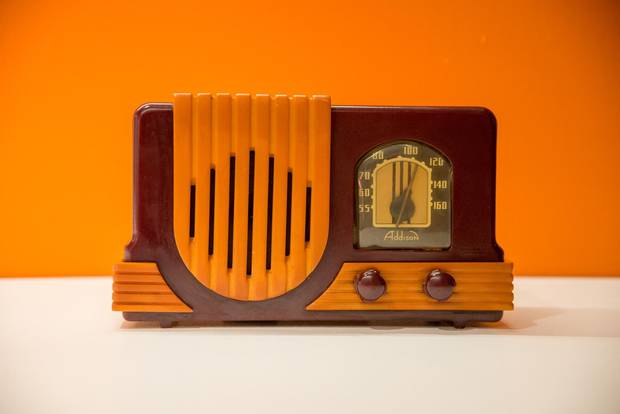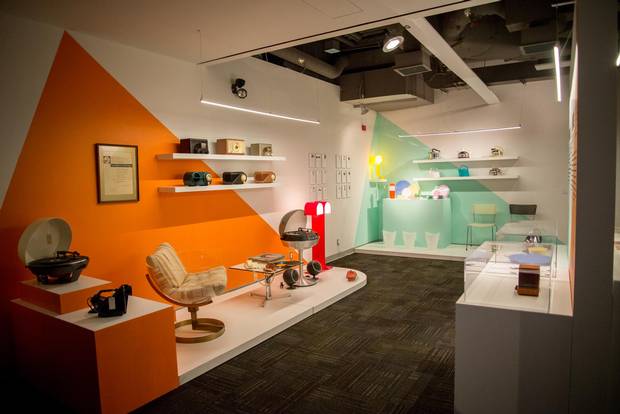In the 1967 movie The Graduate, there's a now-famous scene that nicely captures the mixed feelings with which the postwar world regards plastic. In it, a businessman tries to convince young Benjamin Braddock (played by a young Dustin Hoffman) that the key to the future lies in "one word – are you listening? – plastics." Their brief, oft-quoted exchange reflects our long-conflicted views about the so-called miracle material, as plastic was initially touted: It's the cutting-edge stuff our modern lifestyles are made of, yet also soulless and artificial, the antithesis of the natural, a synonym for fake.
Has there ever in the history of design been a substance that inspires such ambivalence?
This question came repeatedly to mind as I walked through the Design Exchange in Toronto recently. Its latest exhibition, a small, strong show called Classic Plastics, features an array of product and furniture designs from the forties to the present. Culled from the DX's permanent collection, the all-Canadian wares embody not just the versatility and malleability of their defining material, but also its place in the zeitgeist. In one corner, stereo units like the groovy Plexiglas-capped Circa 711, regarded by previous generations as avant garde, have transmogrified into the classics of the exhibition's title. In another, small kitchen appliances once considered utilitarian at best and disposable at worst (a standout is Sid Bersudsky's forties-era kettle with sinuous bakelite handle) are distinguished today for their beauty and durability.
"It's amazing how far plastic was and continues to be pushed," Nina Boccia, the Design Exchange's director of programs, said as we toured the exhibition.
Among other highlights of the show, curated by Tara Akitt, are the bullet-shaped, "increasingly more radical" Midge radios fashioned out of moulded Bakelite by Ottawa-based Northern Electric in the fifties, the modular "lollipop" seating that Robin Bush created for Toronto's then-new airport terminal at the dawn of the 1960s and the sublimely simple stacking Gym chair envisioned by Andrew Jones for Keilhauer in 1997.

Toastess Electric Kettle, 1997: Designed by appliance heir Glenn Moffatt and made in Pointe-Claire, Que., this kettle was composed of candy-coloured injection-moulded polypropylene for a high-tech effect.
As a child of the Me Decade, I grew up with many of the mini-masterpieces on view in Classic Plastics, from the sleek Contempra telephone designed by John Tyson in 1968 (ours had pride of place on a dedicated telephone table in my parents' front hall) to Julian Rowan's iconic 1968 polypropylene Thermos flask, a version of which nestled into my bright-orange Road Runner lunchbox, also made of plastic. Once, I accidentally dropped that Thermos on my daily walk to school; when I picked it up and emptied the contents, I discovered that the flask's glass interior had shattered, although the body itself was unscathed. Back home, my mother tossed the Thermos in the trash, but ruefully, as the plastic flask was largely intact. It would probably still be usable today if its breakable inner shell hadn't failed it.
These days, it is much more fashionable to work with reclaimed wood or hand-blown glass than it is to design with plastic, even as a surprising number of high-end designers, from Marcel Wanders and Tom Dixon to the luminaries at Kartell in Italy (where cutting-edge polycarbonates have never fallen out of favour), continue to embrace the medium.
"I have loved plastic since I was a child," the Canadian designer Karim Rashid, whose iconic Garbo trash can and Oh chair for Umbra are featured in the DX show, said via e-mail from New York.
As a kid he wrote, his bedroom was full of "brightly coloured plastic objects" – including "a warm yellow Kartell mushroom lamp" and "an oversized orange alarm-clock radio by Howard Miller" – that played "a significant and formative role" in his life.
"For me, plastic wasn't just another material," he continued. "It was the lively, energetic material of all materials. I would argue that plastic is now [an integral] part of our nature. Polymers have democratized our consumer landscape and afford us the highest-quality inexpensive goods [possible]."

Addison Radio, 1940: This ‘Waterfall’ model created in a Toronto plant after the Second World War and popular among collectors, is made of Catalin, a phenolic resin that took on vivid hues better than other plastics of the time.
Jef Hancock, a co-founder of Parker Barrow, a design studio based in Los Angeles, is also a fan. "I've used plastic so many ways, from powder coating to lighting fixtures," Hancock told me. "What I like about it is its combination of availability, flexibility and ease of tooling and finishing. It is light or heavy, soft or hard. It can be blended with other compounds. Then you can grind it up and start all over again. It's exciting to me to see what can come from the byproducts of processes going both ways: creating or recycling."
Accessibility, ease of use and cost have always been among plastic's selling points. And the thermoplastics that have supplanted first-generation types are easier to recycle (plus more recycling is going on than ever before). But can plastic ever be considered a sustainable material, one that the 21st century can embrace without guilt or harm?
In her 2011 book Plastic: A Toxic Love Story, U.S. author Susan Freinkel writes that the material should be evaluated and employed just like any other modern resource, its sustainability measured less by plastic's makeup than by what we make with plastic.
"Plastic should be a high-value material," Freinkel notes, quoting the California environmentalist Robert Haley. "[It] should be in products that last a long time and, at the end of their life, you recycle. To take oil or natural gas that took millions of years to produce and then to make a disposable product that lasts minutes or seconds [is] not a good way of using this resource."

Thermos Flask, 1962: The first Canadian all-plastic vacuum Thermos, designed by Julian Rowan and manufactured in Toronto, was made of heat-resistant polypropylene well before American Thermos models were, setting the industry standard.
In other words, fewer disposable water bottles and shopping bags, more long-lasting, thoughtfully designed products that consumers will value and even treasure. "Creating a more sustainable relationship with plastics will require a new dexterity on our part," Freinkel concludes. "It will require us to think about the entire life cycle of the products we create and use."
Already, that is happening in a number of ways. On Jan. 1, 2018, Montreal aims to become the largest municipality in Canada to ban single-use plastic bags, particularly the very thin kind that break down into tiny particles that are often ingested by wildlife and can contaminate recycling or composting processes. Major institutions such as the Bank of Canada, meanwhile, have embraced plastic for, yes, sustainable reasons: In addition to being harder to counterfeit, our new polymer bank notes are more durable and therefore longer-lasting than paper money.
At the same time, design companies such as Umbra, manufacturer of Rashid's signature creations, continue to expand the mass-market possibilities of plastic. Case in point: The Garbo can, long made of polypropylene, is now fashioned out of plastic derived from corn, which, like other bioplastics created from plant-based sources, does biodegrade, but either very slowly (in dedicated landfills and compost heaps) or very expensively (through a controlled industrial process).
According to Hancock, whose clients have included restaurants and hotels, there are opportunities in such limitations. "Being a long-time up-cycler, I can sometimes appreciate the fact that plastic doesn't quickly break down, as it gives me a chance to give it another life. In my opinion, there is no free ride here on Earth. Everything takes something to become something – we need massive amounts of electricity, wiring and batteries to not burn fossil fuels, and we need massive amounts of plastics to not keep cutting down trees. Efficiency will be the future."
Biodegradable plastics that don't immediately end up in landfills? Judiciously considered uses that save trees and provide second or even third lives for stuff?
Maybe that love story, once toxic, could have a happy ending after all.
Classic Plastics runs at the Design Exchange in Toronto (dx.org) until August.
